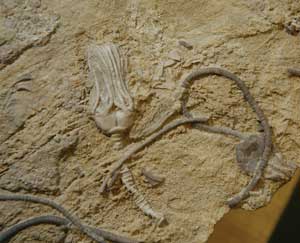|
News Notes
Paleontology
The color of crinoids
 There’s life in those old fossils yet: Scientists have discovered complex organic molecules still preserved within 350-million-year-old crinoid fossils. Because the molecules are slightly different from species to species, the find could offer a new way to track the creatures’ evolution through time, the scientists say.
There’s life in those old fossils yet: Scientists have discovered complex organic molecules still preserved within 350-million-year-old crinoid fossils. Because the molecules are slightly different from species to species, the find could offer a new way to track the creatures’ evolution through time, the scientists say.
Fossils of ancient sea creatures called crinoids still contain some organic molecules. Because they are species-specific, these molecules could help scientists track the crinoids’ evolution over time. Photograph is by Kevin Fitzsimons, courtesy of Ohio State University.
Colorful crinoids — also known as sea lilies — still exist today, and are part of a group of animals called echinoderms, which includes starfish and sea urchins. Modern deep-sea crinoids clinging to the seafloor have small stalks topped by fronds that resemble “a little clump of feathers,” says Christina O’Malley, a graduate student in earth science at Ohio State University and lead author of a study presented Oct. 25 at the Geological Society of America meeting in Philadelphia. Crinoids also come in a rainbow of colors, from red to purple to orange.
Ancient crinoid fossils are also often brightly colored. The pigments are actually organic molecules that may or may not have colored the animal when it was alive, but the lingering color in the fossils suggested to the researchers that the molecules might still be present, O’Malley says. That is possible in crinoids because, unlike most invertebrates, which have a skeleton outside the body, an echinoderm’s highly porous skeleton is actually tucked between tissue layers — meaning that it has live tissue in its skeleton, she says. That tissue can become trapped during fossilization and preserved.
The researchers separated the pigments from the fossils, then identified the organic molecules based on their mass. The next step is to determine whether the molecules vary between different fossil species, O’Malley says. Among modern crinoids, “the more closely related the species are, the more similar these molecules are,” she says. If that holds for the ancient species, it may be possible to use the molecules as biomarkers to trace the ancient crinoids’ evolutionary family tree.
Carolyn Gramling

 Subscribe
Subscribe

